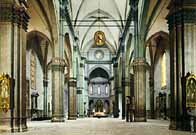
The interior of the Cathedral
The interior of Santa Maria del Fiore, built on Arnolfo's project (1296-1302) and completed by Francesco Talenti (1349-69), is really imposing. The centre nave is created by great Gothic vaults resting on wide arches that divide the space in to four square bays, giving a more classical than Gothic harmony to the structure. The arches rest in their turn on powerful composite pilasters similar to those Francesco Talenti used for the Loggia dei Lanzi. What we see today is probably the result of Talenti's variations on Arnolfo's design, which foresaw a major number of bays and pilasters (and therefore windows). The fresco of the old Santa Reparata in the Museum of the Bigallo also gives us this impression.
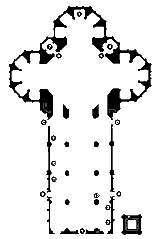
The plan of the Cathedral
The structure has a deliberate and majestic feeling about it and immediately
forces the eye towards the basilica's spatial fulcrum, formed by the chancel
and the cupola above: this search for a "centre of gravity"
is another element that differs from the Gothic style, which tended
more to create a vertical spatiality without need for hierarchies.
This is an obvious sign of the permanence of classical taste in Florence,
the supporter of an "order" among things, which was to
be found in every epoch.
The Duomo is built on the plan of a Latin cross and its naves are 153 metres
long by 38 metres wide. The transept is 90 metres long while the cupola is
45 metres in diameter, the same size as the Baptistery:
this was an unusual width in Gothic architecture and was to create a great many
technical problems when the time came to close the whole area with a vault. Only
Brunelleschi was capable of resolving the challenge launched by Arnolfo.
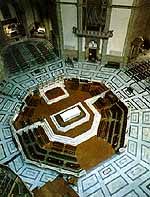
The chancel and high altar
The design and execution of the polychrome marble flooring is attributed
to Baccio d'Agnolo and Francesco da Sangallo (1520-26). The restoration
work after the 1966 flood showed that pieces of marble that had previously
been used for the facade by Arnolfo had been reutilized,
the other way up, for the floor. The naves and the tribune are illuminated
by the beautiful 15th century stained glass windows created by artists like
Ghiberti, Paolo Uccello, Donatello and Andrea
del Castagno.
The internal facade, which is the oldest part of the church, should be observed
with some care. The lunette above the door in fact contains a mosaic by Gaddo
Gaddi (early 14th century), who also worked on the mosaics in
the Baptistery. The three round stained glass windows, together
with the one in the cupola, were carried out from cartoons by Ghiberti (1403-13),
and can be said to be among the few remaining proofs of his pictorial activity.
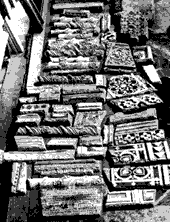
Marbles from the facade
used for the flooring
The famous clock on the inner facade, with its quadrant and medallions, was painted
in fresco by Paolo Uccello (1443). It is one of
the few mechanical clocks that still exists and works: it has only one hand and
tells the time by going round in the opposite direction compared to modern clocks
because it measures the time from sunset to sunset. The wall also contains the
tomb of Bishop d'Orso (1321), one of the most beautiful works of sculpture in
the Cathedral.
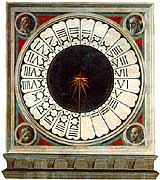
Mechanical clock on the inner facade
The lefthand nave contains frescoes by Paolo
Uccello and Andrea del Castagno while
the Last Judgement by Vasari-Zuccari
is painted in the cupola. Here we can also see the historic,
though not particularly well painted, panel by Domenico di Michelino (1465) of
Dante, Florence and his "Comedy".
It is the only homage that the city ever made to the great poet in the past.
The crucifix in wood above the high altar is the work of sculptor Benedetto da
Maiano (1477). Three apses, separated by the two sacristies (bas-reliefs
by Luca della Robbia), open into the transept, each one divided into five chapels.
The chapel behind the high altar contains Ghiberti's masterpiece of goldsmithery:
the Urn of St. Zanobus. Below the
cupola stands the huge octagonal chancel curtained off by an elegant marble balustrade by
Baccio Bandinelli (1555), which was once decorated with numerous bas-reliefs
and statues, many of them now conserved in the Museum of the
Opera del Duomo.
